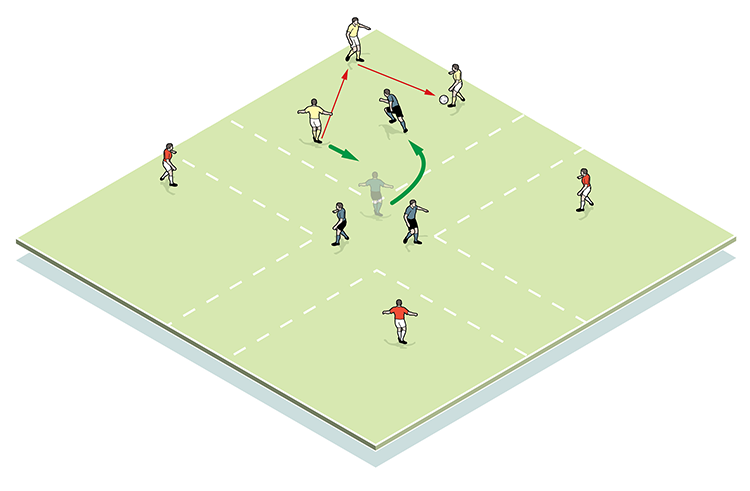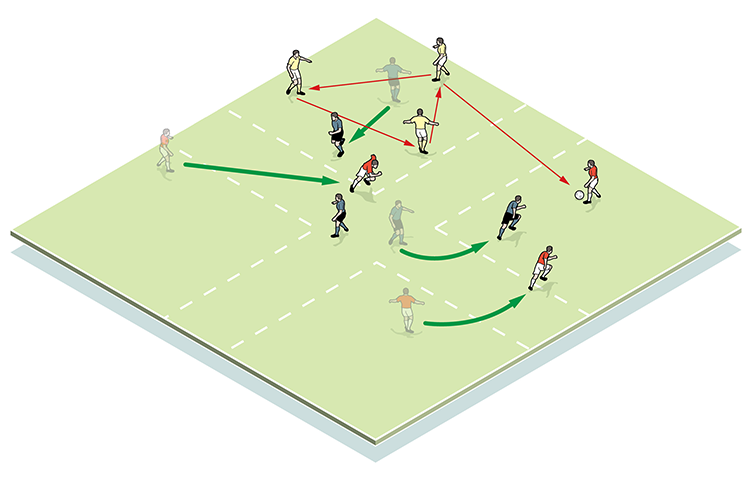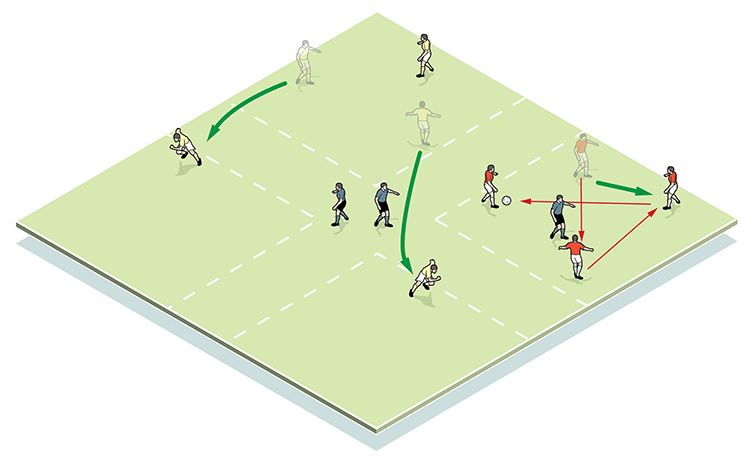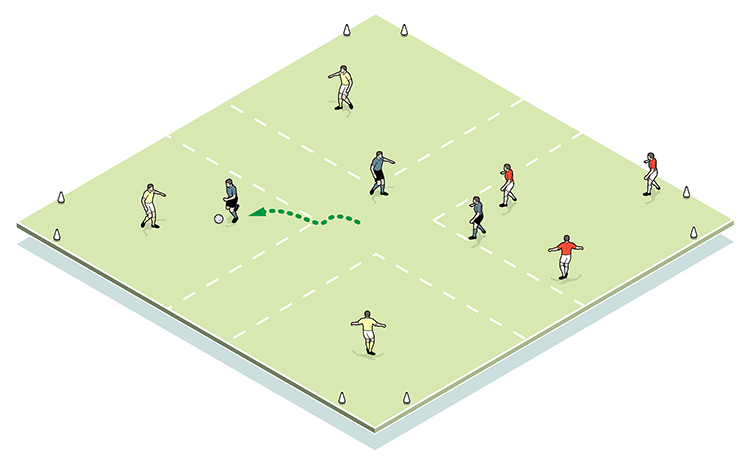




OUR BEST EVER OFFER - SAVE £100/$100
JOIN THE WORLD'S LEADING PROFESSIONAL DEVELOPMENT PROGRAMME
- 12 months membership of Elite Soccer
- Print copy of Elite Player & Coach Development
- Print copy of The Training Ground
You are viewing 1 of your 1 free articles
Transition game
Help your players feel comfortable when keeping the ball in tight areas with this session which is based on defending in overloads yet incorporates both defensive and offensive elements.
| Area | 20x20 yards |
| Equipment | Cones, balls |
| No. of Players | 9 (3 teams of 3) |
This session is based on defending in overloads yet incorporates both defensive and offensive elements, as well as helping players feel comfortable when keeping the ball in tight areas. It requires quick movements and good reactions.
It is important to practise this because it brings together all game components in one scenario – attacking, defending, passing, and the need for players to be alert to receiving the ball or stopping an opponent.
The session also looks at recognition of space, when to play beyond the opposition and when to play in between.
What do I get the players to do?
We set up a box in the shape of a St George’s flag, using cones to mark out the internal lines. The yellow team starts with the ball, passing amongst themselves and keeping possession in one box. The red team of three places a player in each of the vacant boxes, while the grey team begins in the centre (1a).
1a

In this instance, the grey team acts as defenders. One enters the three-man box, attempting to win possession from the yellows, whose task is to keep the ball for five passes before transferring it to any red (1b). Should they succeed, the other reds now move to the square where possession is, yellows move to individual squares, and a new grey defender comes forward to break up play (his team-mate returns to the centre) (1c).
1b

1c

Should the ball be intercepted by a grey defender, he must attempt to pass out to a team-mate. If he succeeds, rotate teams so that the yellows (who lost possession) become defenders.
What are the key things to look for technically/tactically?
Defenders need to get out quickly and all players should show awareness of others’ positions in such tight passing areas, as well as being quick to react to possession being overturned. No players should ‘ball watch’. The move also requires quick thinking in the event of possession changing hands.
How do I progress the session?
Progress the session by adding more players, varying the number of touches, or changing the number of passes that need to be completed by the team in possession. Making the playing area bigger increases the need for accurate passing over greater distances.
We also like to add in a goalscoring element whereby if a defender wins possession and passes out to a team-mate, they then turn to attack a goal in any of the three squares protected by a lone opponent (2a).
2a

The player can choose to go alone or might combine with a team-mate to score. Team-mates of the player whose goal is under attack must track back to prevent a goal being scored (2b/2c).
2b

2c

Related Files
Editor's Picks
Attacking transitions
Deep runs in the final third
Using the goalkeeper in build-up play
Intensive boxes drill with goals
Penetrating the final third
Creating and finishing
My philosophy
Pressing initiation
Compact team movement
Coaches' Testimonials

Alan Pardew

Arsène Wenger

Brendan Rodgers

Carlos Carvalhal

José Mourinho

Jürgen Klopp

Pep Guardiola

Roy Hodgson

Sir Alex Ferguson

Steven Gerrard
Coaches' Testimonials

Gerald Kearney, Downtown Las Vegas Soccer Club

Paul Butler, Florida, USA

Rick Shields, Springboro, USA

Tony Green, Pierrefonds Titans, Quebec, Canada
Join the world's leading coaches and managers and discover for yourself one of the best kept secrets in coaching. No other training tool on the planet is written or read by the calibre of names you’ll find in Elite Soccer.
In a recent survey 92% of subscribers said Elite Soccer makes them more confident, 89% said it makes them a more effective coach and 91% said it makes them more inspired.
Get Monthly Inspiration
All the latest techniques and approaches
Since 2010 Elite Soccer has given subscribers exclusive insight into the training ground practices of the world’s best coaches. Published in partnership with the League Managers Association we have unparalleled access to the leading lights in the English leagues, as well as a host of international managers.
Elite Soccer exclusively features sessions written by the coaches themselves. There are no observed sessions and no sessions “in the style of”, just first-hand advice delivered direct to you from the coach.







